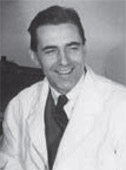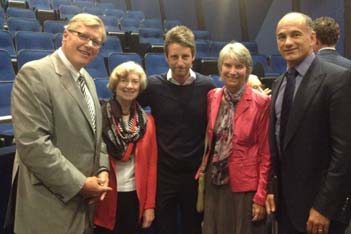Bigelow Lecture: Turning Data
into Performance Management

Bill Bigelow
|
Wilfred (Bill) Bigelow was a pioneer of
cardiac surgery who introduced the use
of hypothermia and electrical stimulation
of the heart. He also introduced
the pacemaker to Canadian surgery. His
trainees populated the surgical programs
throughout Canada, and his lasting
contributions in clinical cardiac surgery,
teaching, and research made him
a legend. The Bigelow Lectureship was
created to honour his memory and has
brought distinguished surgeons and scientists
to the University of Toronto for
Bill Bigelow the past 5 years.
|
Bigelow lecturer Robert Bell obtained his MD degree at McGill, followed
by residency in Surgery at the University of Toronto, and training in surgical
oncology at the Massachusetts General Hospital. After a distinguished career
as a clinical surgical oncologist in the specialty of Orthopaedics, he served
as the Chief Operating Officer of the Princess Margaret Hospital. He has
been Chairman of the Cancer Quality Program for Cancer Care Ontario and
served for 8 years as CEO of the University Health Network. He has recently
accepted the position as Ontario’s Deputy Minister of Health.
Bob’s Bigelow lecture focused on turning data into performance improvement,
using cancer surgery as the focus of his narrative. He reconstructed a story that
began in 2000, when the healthcare system was chaotic. Patients were being sent
to Buffalo and Rochester for radiation therapy. The facilities in Ontario were
inadequate to meet the challenge brought by advances in treatment of breast and
prostate cancer. Allan Hudson, former CEO of the UHN, convened a Quality
Council to oversee cancer care. This was a revolutionary
idea to have an arm’s length quality assurance oversight
group. Bob showed an excellent slide of the increasing need
for cancer treatment facilities with a baseline requirement,
increases related to the aging of the population and the
superimposed increases related to population growth. The
journey of a patient was described beginning with prevention
through screening, to diagnosis and treatment. There
are clear-cut opportunities for improvement in the control
of cancer. For example, the rate of smoking in Ontarians is
18%; it is only 14% in British Columbia, and even lower
in California. A dramatic turnaround resulted from the
oversight committee’s actions. There is now a 90% return
of complete pathology reports within 14 days, with detailed
quality markers. For example, the requirement that 8 nodes
be sampled and negative in colon cancer allows the surgeon
to say definitely that the lymph nodes were negative, obviating
the need for chemotherapy. The Rapid Assessment and
Management Programs have resulted in excellent access to
diagnosis and treatment for patients with cancer (see Summer 2010 article).

Bob Bell, Jane McKinnon, Mat Bigelow, Gail MacNaughton and Christopher
Caldarone
“Data is useless without performance management systems”
is the theme Robin McLeod is emphasizing in her
new role as VP, Clinical Programs and Quality Initiatives
at Cancer Care Ontario. She meets regularly with the
LHINs (Local Health Integration Networks) and Bob
will visit each of them yearly. He tells each director: “I
want you to tell me what’s needed, and I’ll be back in one
year to see what you did about it.”
He gave a compelling discussion of mismanagement of
Intensity Modulated Radiotherapy, citing the New York
Times articles on deaths from misuse (http://www.nytimes. com/2010/01/27/us/27radiation.html?pagewanted=all).
The NHS in the United Kingdom requires responsibilities
as part of the mandate of the healthcare teams. These
include end of life treatment plans, advance care directives,
and avoidance of the all too often use of chemotherapy
within two weeks of the end of life. “Rateyourdoctor.com”
is coming to Canada and some of our doctors have been
extraordinarily well rated by their patients.
“We have moved from the chaos of 2000 to a position
among the best in the world in our treatment of cancer.
Minister of Health Deb Matthews deserves praise for
the improvement in the quality of care. CEO pay is
now linked to the quality of care by the Excellent Care
for All Act, and MOH funding is linked to quality and
outcomes. The priorities for the future include homecare,
which is currently chaotic with 650 companies and
no oversight. It is like the year 2000 for cancer care. The
5% of patients who are poorly served and responsible
for 60% of the cost of healthcare are bouncing around
between caregivers and institutions.”
Bob closed with encouragement to narrow the gap
between the early and late adopters in the evolution of
improvement and innovations. He reminded us that
50% of cardiac surgery outcomes in the United States are
publicly reported, and we can expect that this will come
to Canada. Not everyone agrees that this is a great idea (1).
The Bigelow Lecture was an inspiring and encouraging
good news story about healthcare, quite the reverse of
what we generally see in the newspapers. We look forward
to more from our surgeon in the Ministry.
M.M.
|
A Short Interview with Bob Bell
Bob Bell has been Deputy Minister of Health since June
of this year. He is enthusiastic, confident, and having
fun. “It is very positive to have a majority government,
so that a four - year plan can be made and acted upon. It
is different to be in the Ministry as opposed to working
as a Hospital CEO - nobody in the healthcare system
is working for the Deputy Minister. The challenge is to
introduce change management using data and performance
management. There will be particular emphasis
on homecare and integrating the elements of the healthcare
system and sustainability.
For surgeons, the plan is to further elevate the bar and
bring in NSQIP (National Surgical Quality Improvement
Program) to Ontario (see Winter 2010 article). Bob would like to do a Northern New England
Cardiac Surgery style of co-consultation1. Fortunately,
we have established groupings – the LIHNS, an advantage
for managing change.
Q: How should we train surgeons to fill the role that
you have been and continue to fill in healthcare policy
and institutional leadership?
A: This is not easily taught in a formal program- it is
best to learn as you go along- go to work, then start picking
up courses as Barry Rubin has done. Barry is super
example of a savvy healthcare executive. I had an interest
in coordinated care because my practice was focused on
sarcoma, requiring integration of multiple specialties.
Interestingly, the new CEO of UHN Peter Pisters is also
a sarcoma specialist.
Q: How can you use the media to accomplish the
goals of the Ministry of Health?
A: Well, you certainly require a thick skin to deal with
the criticism, since that is a primary mission of the press.
Productive and positive columnists like Andre Picard can
be a great help.
Q: How will you deal with the critique that you are
a hospital guy, ill–equipped to deal with the family
practice and primary care issues?
A: I was a family doctor and emergency room doctor for
three years before I went into surgery. My knowledge of
this sector of healthcare is not as good as my hospital
knowledge, but I am actively engaged in this challenge.
I am very pleased with how our Ebola Preparedness
is coming along. We have had very good input from
Jennifer Gibson from the Joint Center for Bioethics,
teaching the Principles of Healthcare Ethics, such as the
importance of rest for the workers and other principles
derived from the work on SARS epidemic by Ross
Upshur and his colleagues.
M.M.
REFERENCES
1. O’Connor GT, Plume SK, Olmstead EM, et al. A regional
intervention to improve the hospital mortality associated with
coronary artery bypass graft surgery. JAMA 1996; 275:841-6.
|